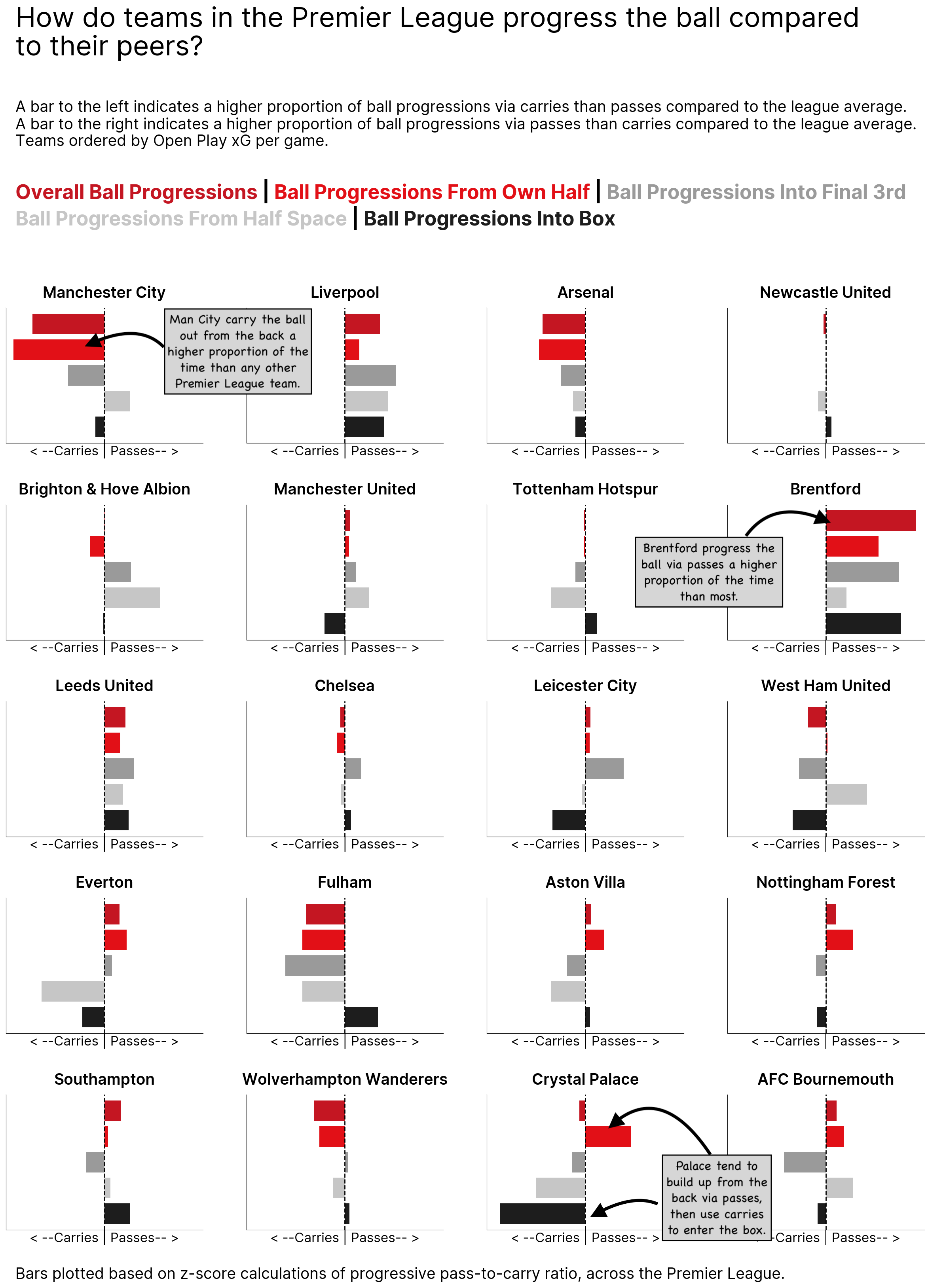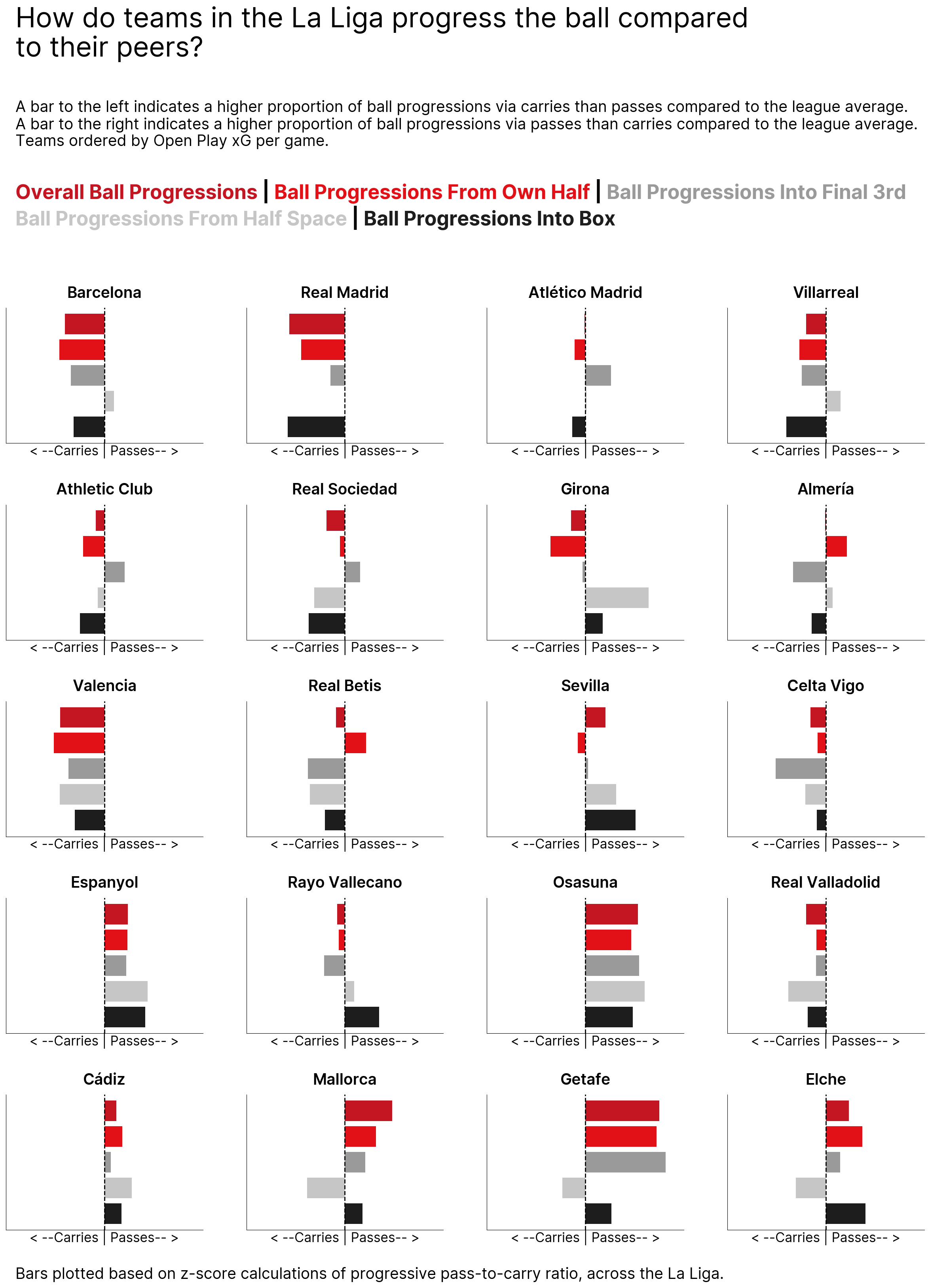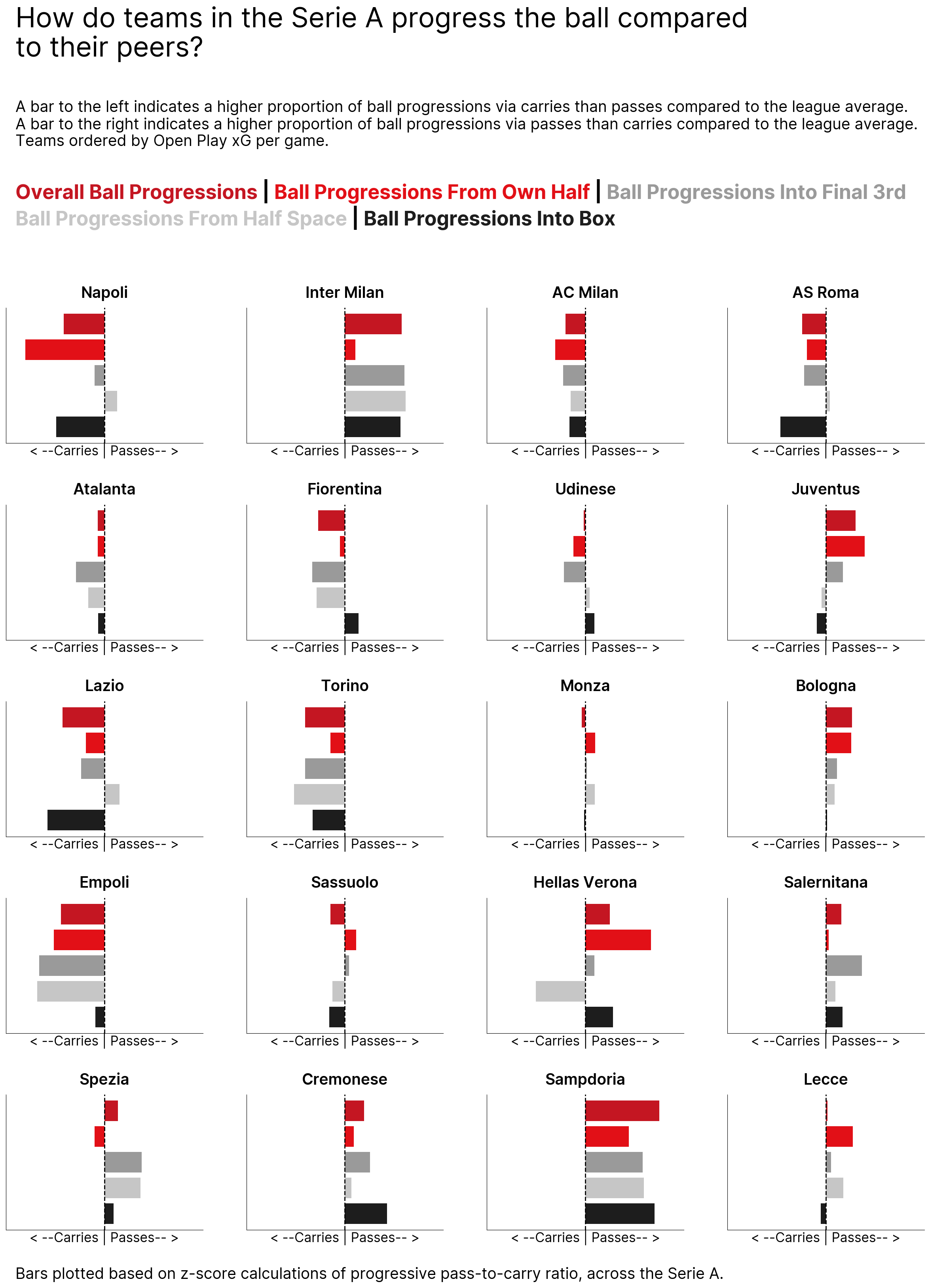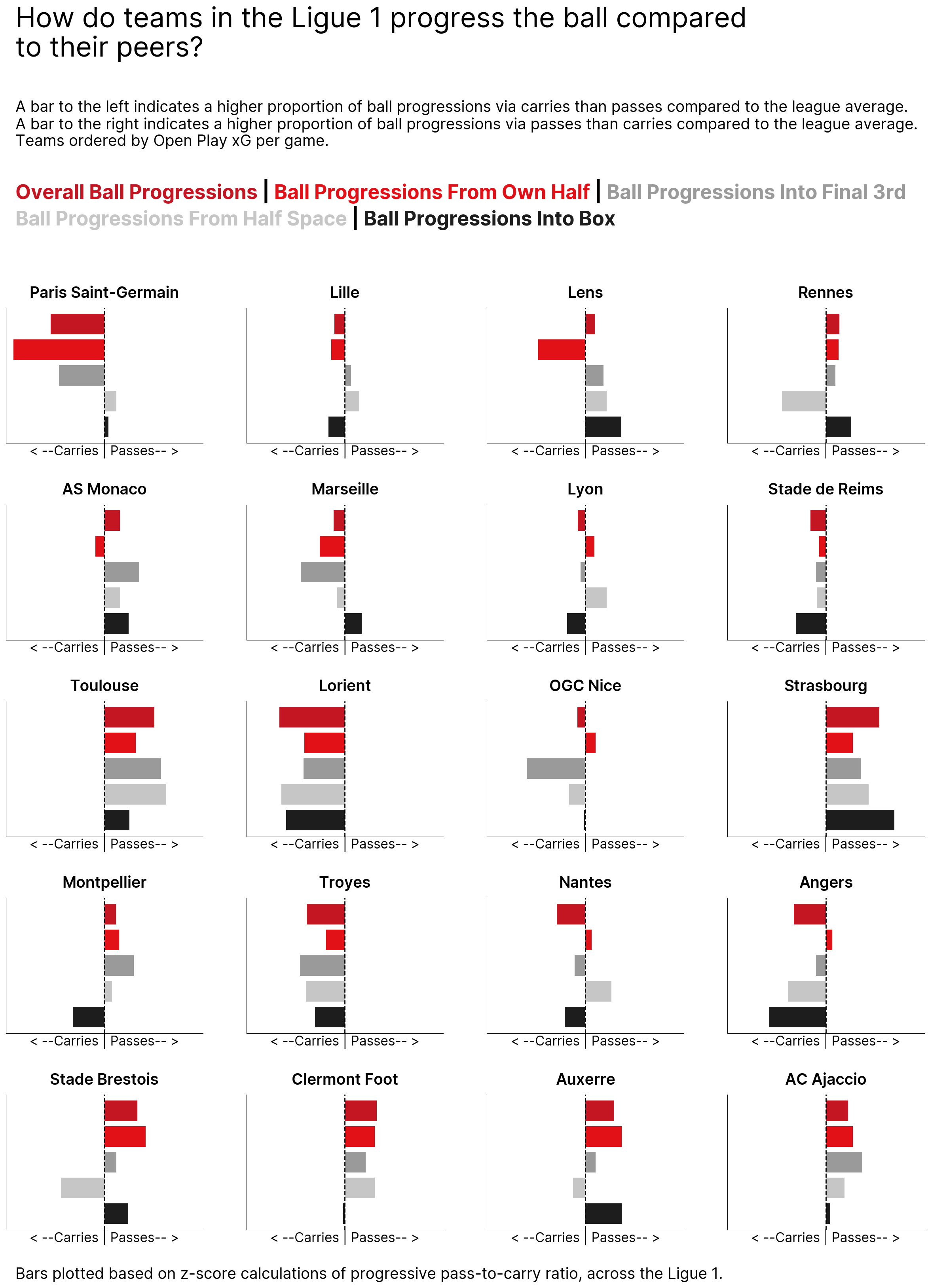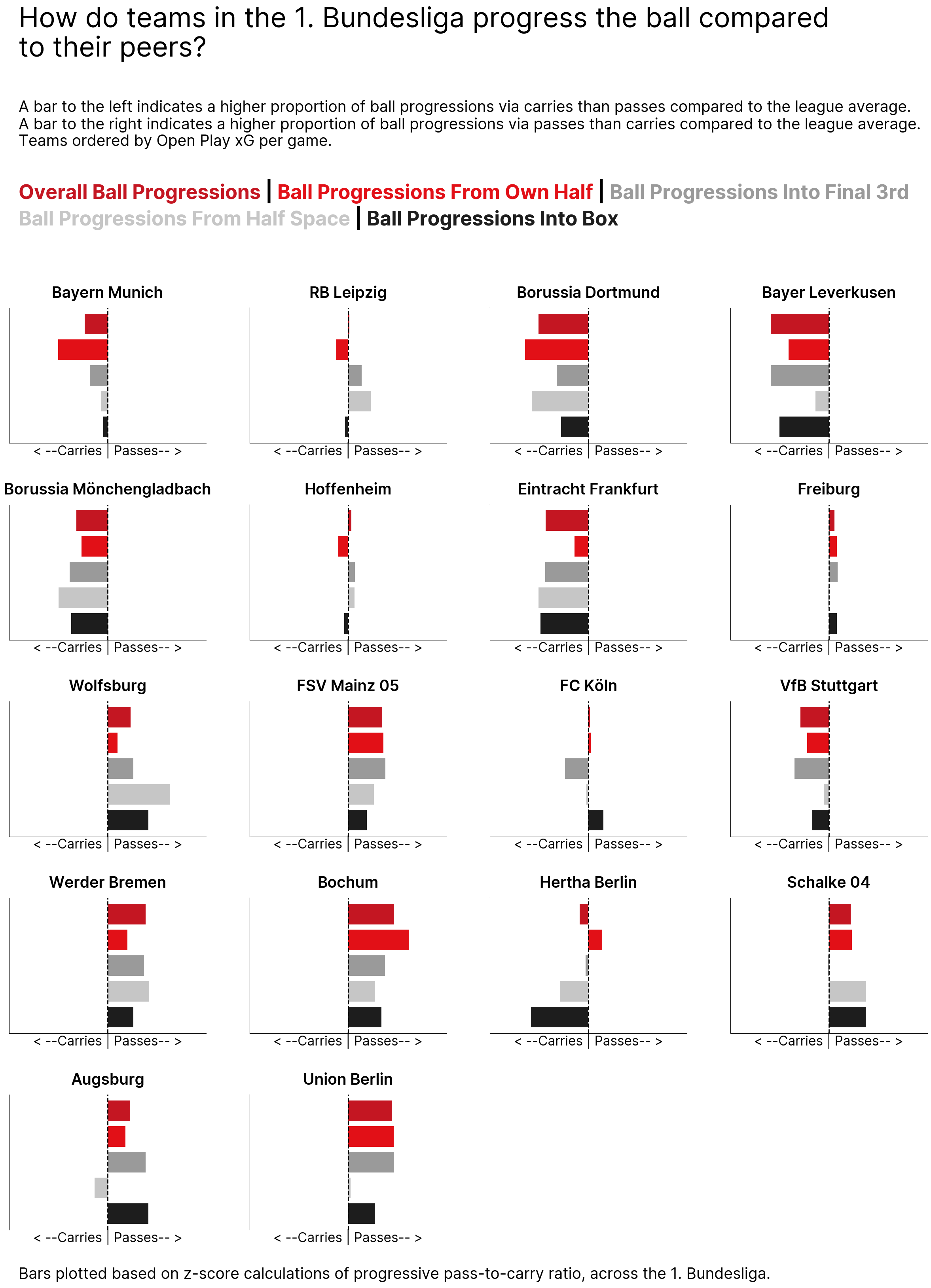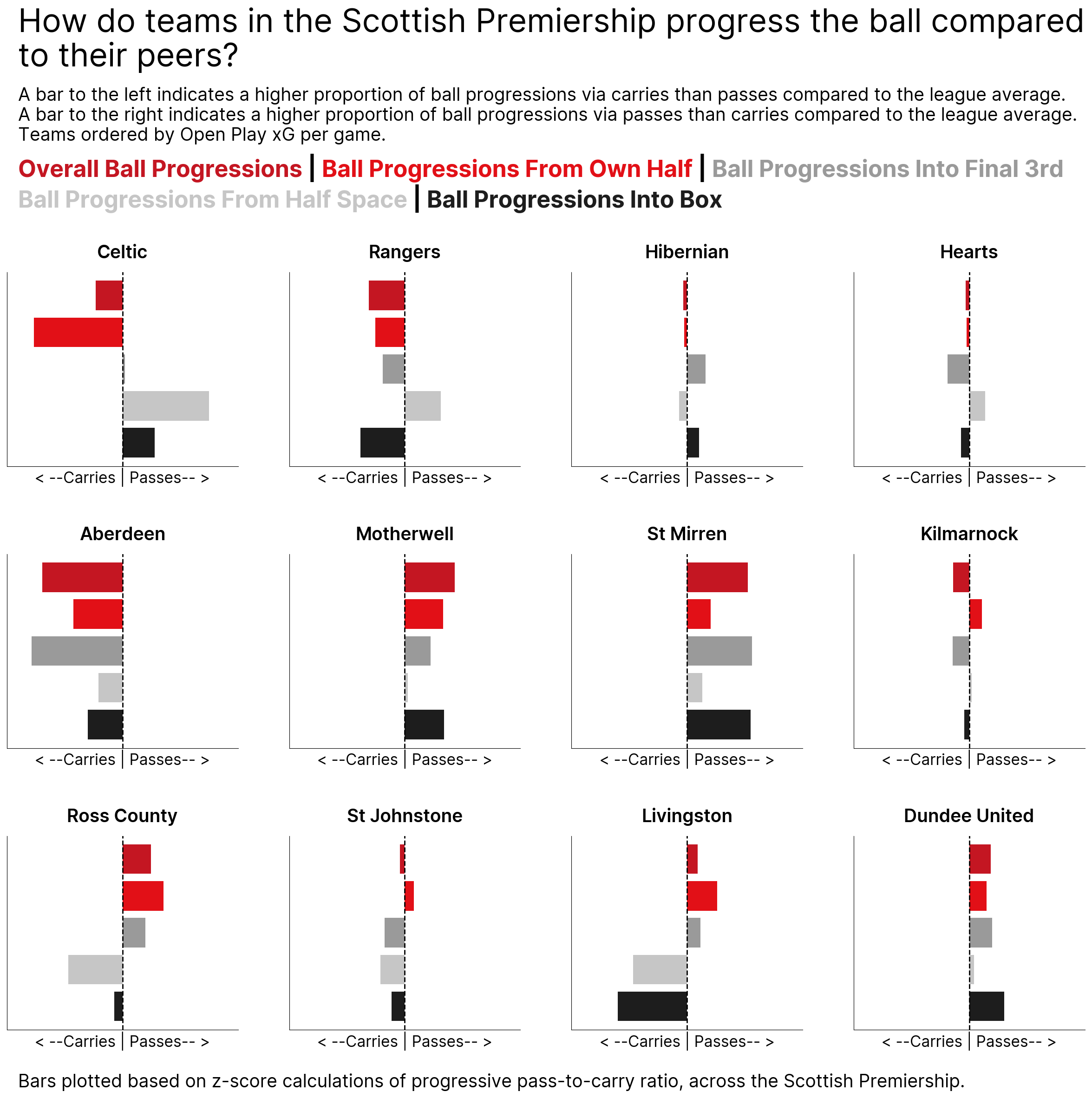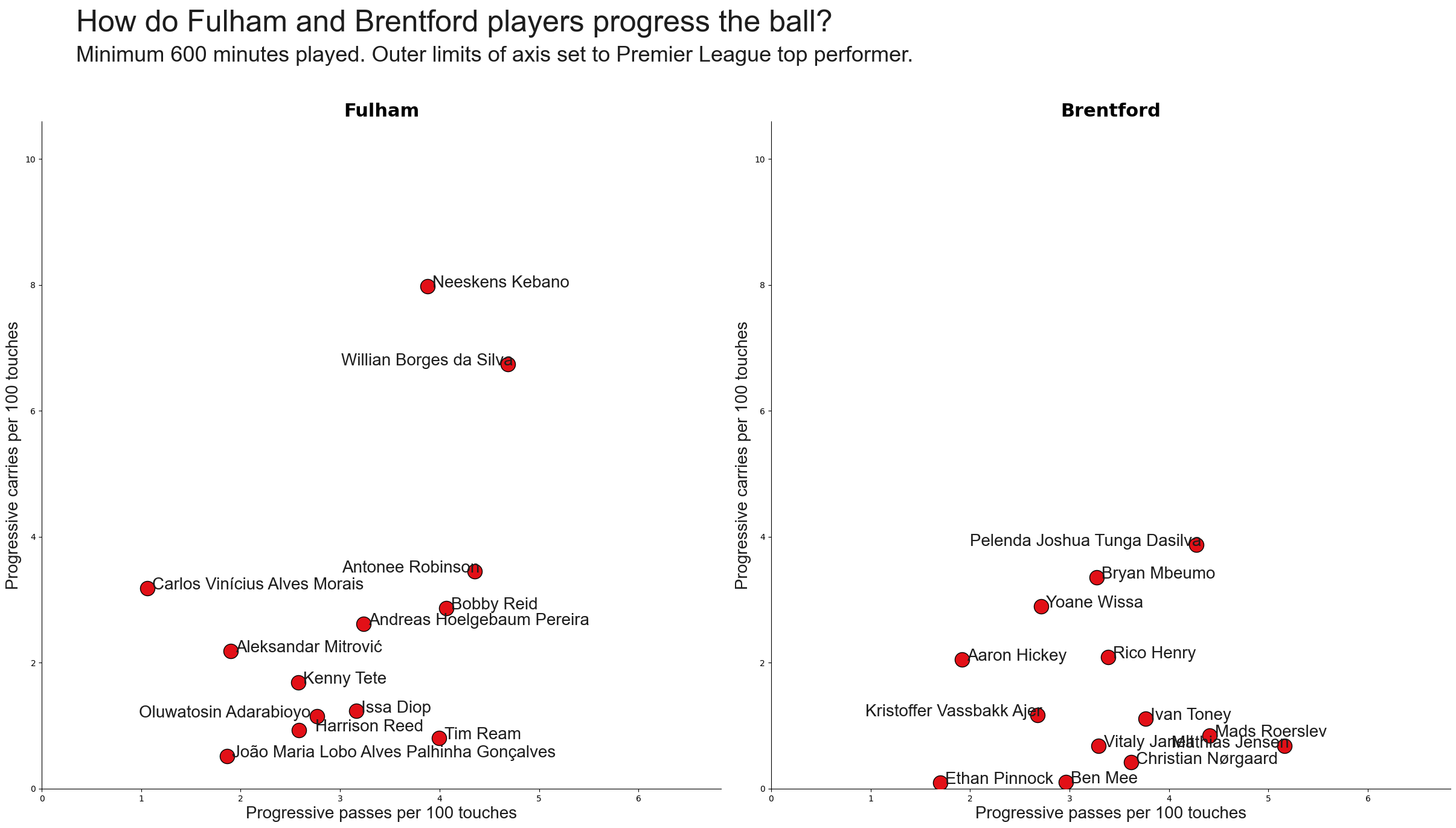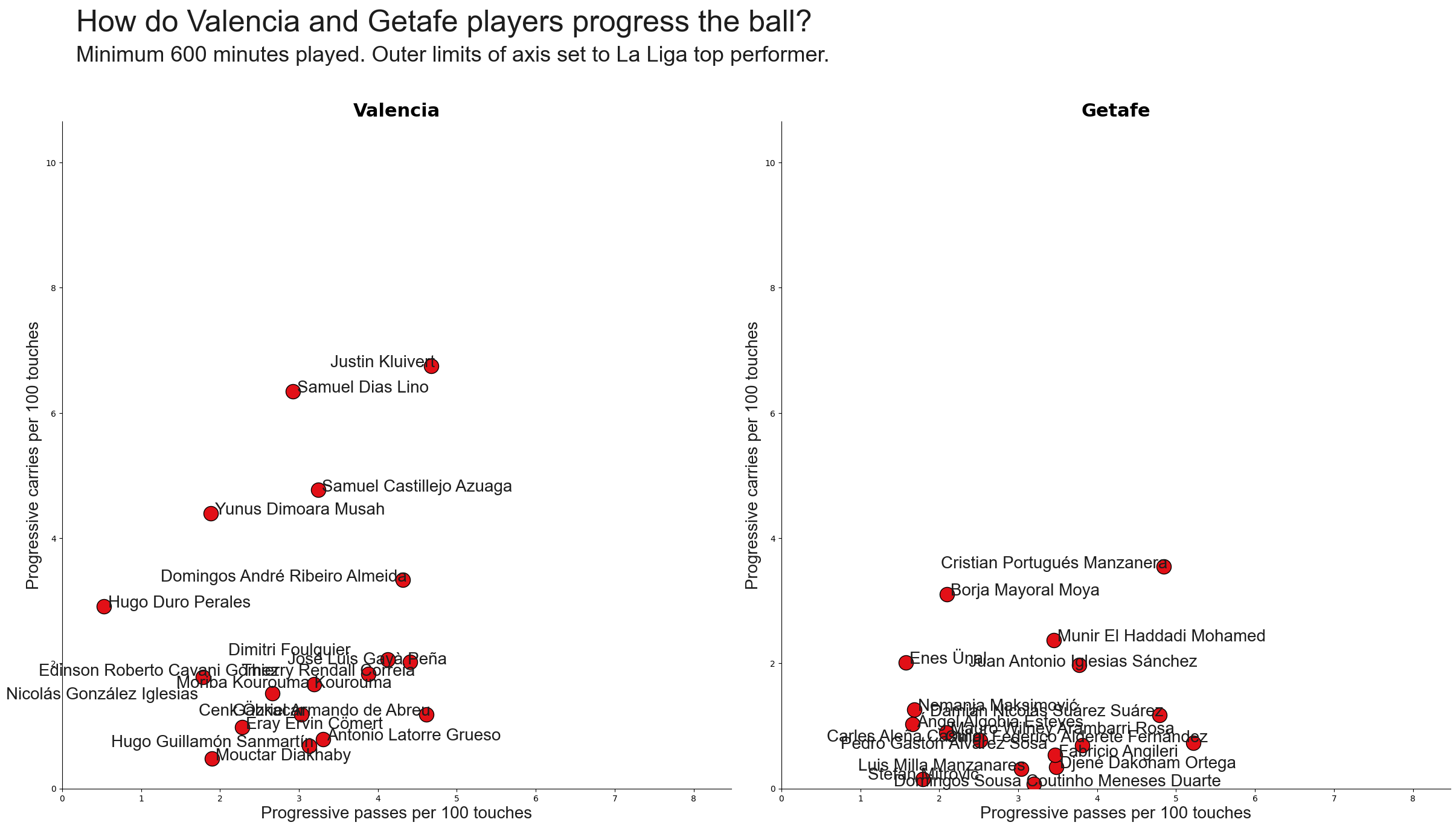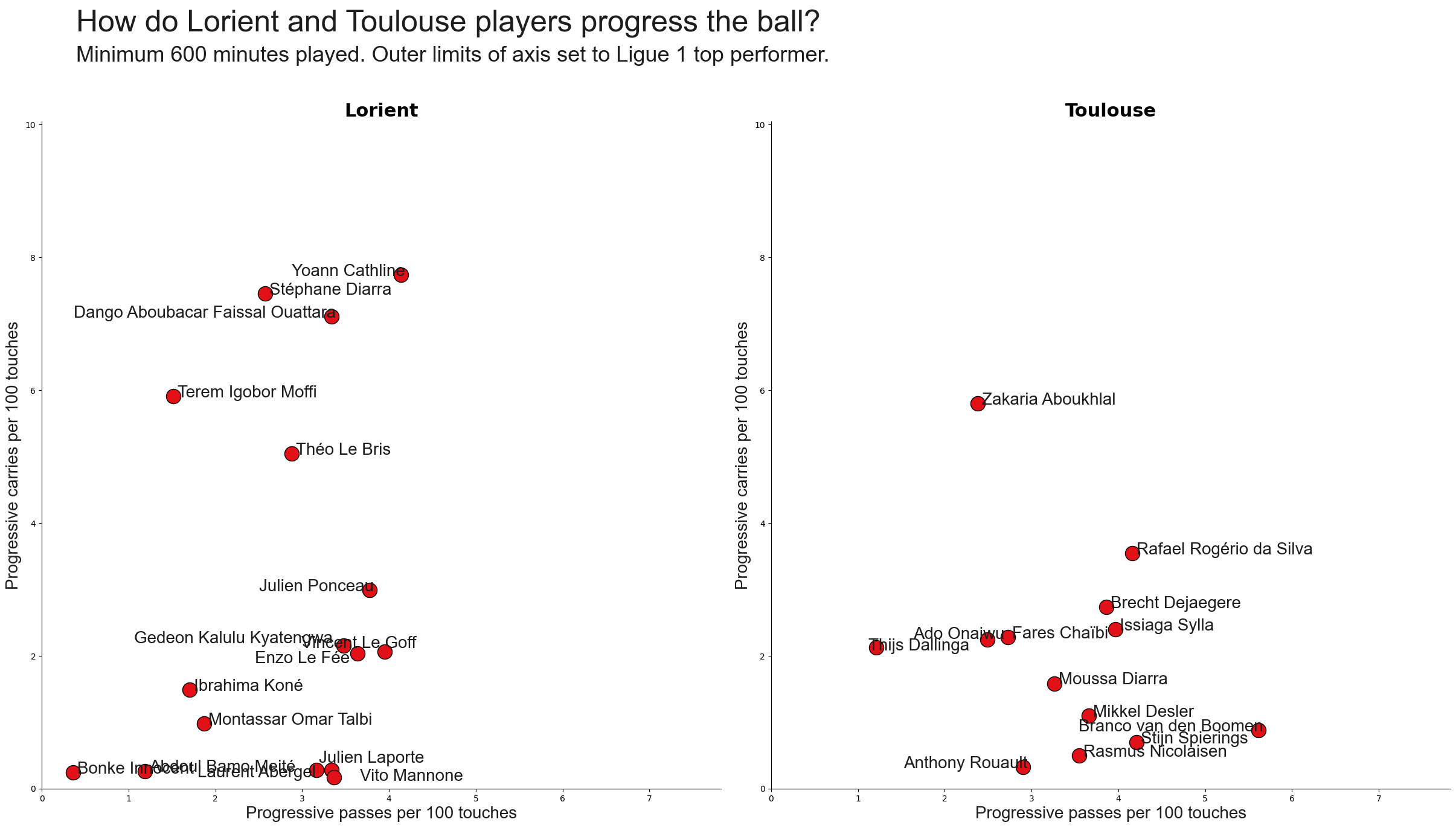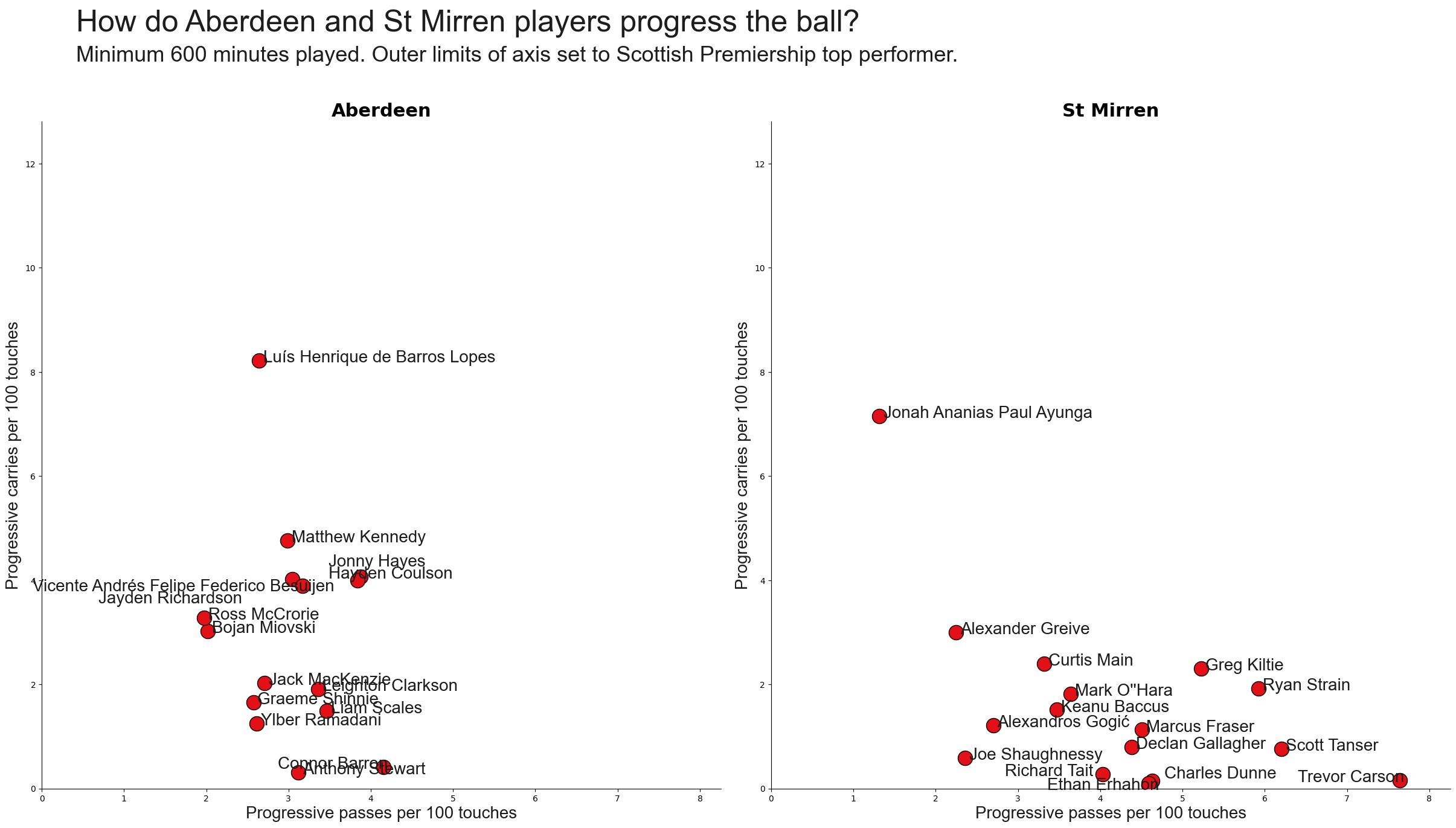There are many ways to win a football match (and even more ways to lose one). How any manager, coach, team or club attempts to do so is their prerogative. However, progressing the ball towards the opposition’s goal is fairly fundamental in any method. The following is an exercise in differentiating between teams, leagues and players that opt to progress the ball via passing compared with those that look to do so via carries.
You’d be forgiven for thinking that the #football channel in the StatsBomb Slack is a hive of high-brow concepts and overarching solutions to the beautiful game’s most complex problems. It’s not. (Those conversations do happen somewhere at StatsBomb, but it’s not here). It’s generally full of hot takes, transfer gossip and [insert club]’s latest crisis.
However, on occasion, it does stir a debate that grabs the attention of the StatsBomb masses. And therein lies the foundations of this piece. What started as a seemingly innocuous question about the ratio of ball progressions via passes to carries has led me down the garden path to… well, I’m not quite sure where it has led me. But it got me poking around in our data and arriving at the insights that I present henceforth.

Before I get tucked in, a little bit of housekeeping.
● Firstly, this is NOT an attempt to identify who (or what method) is better (or worse) at progressing the ball. My primary focus here is to identify the stylistic choices around which teams decide (or perhaps are forced) to move the ball closer to the opposition’s goal - via passes compared to carries.
● Secondly, ball progression can - and is - measured in a myriad of ways. You can read about the various methods and the merits of each in Will Thomson’s excellent piece here.
For the purposes of this piece, I’ve decided to compare the ratio of progressive passes to carries for a group of leagues, and then teams within those leagues. The methodology I have opted to use to measure ball progression in this instance is:
● Any successful pass (set pieces excluded) or carry (including dribbles) that moves the ball at least 25% of the remaining distance towards the centre of the goal.
● At the player level, I have made adjustments to allow for opportunity. By normalising outputs by the number of touches a player has, we can get more of a feel for playing style than team quality.
And so, with my definitions locked in, and some vague notions floating around my head, I set off on my quest to see if I could categorise some leagues, teams and players as either progressive passers or progressive carriers. Who are the pass-first teams? Which players are carrying kings? And in what leagues are you more likely to see a sweeping pass than a mazy dribble?
Comparing Methods Of Ball Progression Across Leagues
In an effort to keep this concise, I’ve restricted my analysis to six European leagues – the Big 5 plus the Scottish Premiership (because… well, somebody’s gotta fly the flag!).
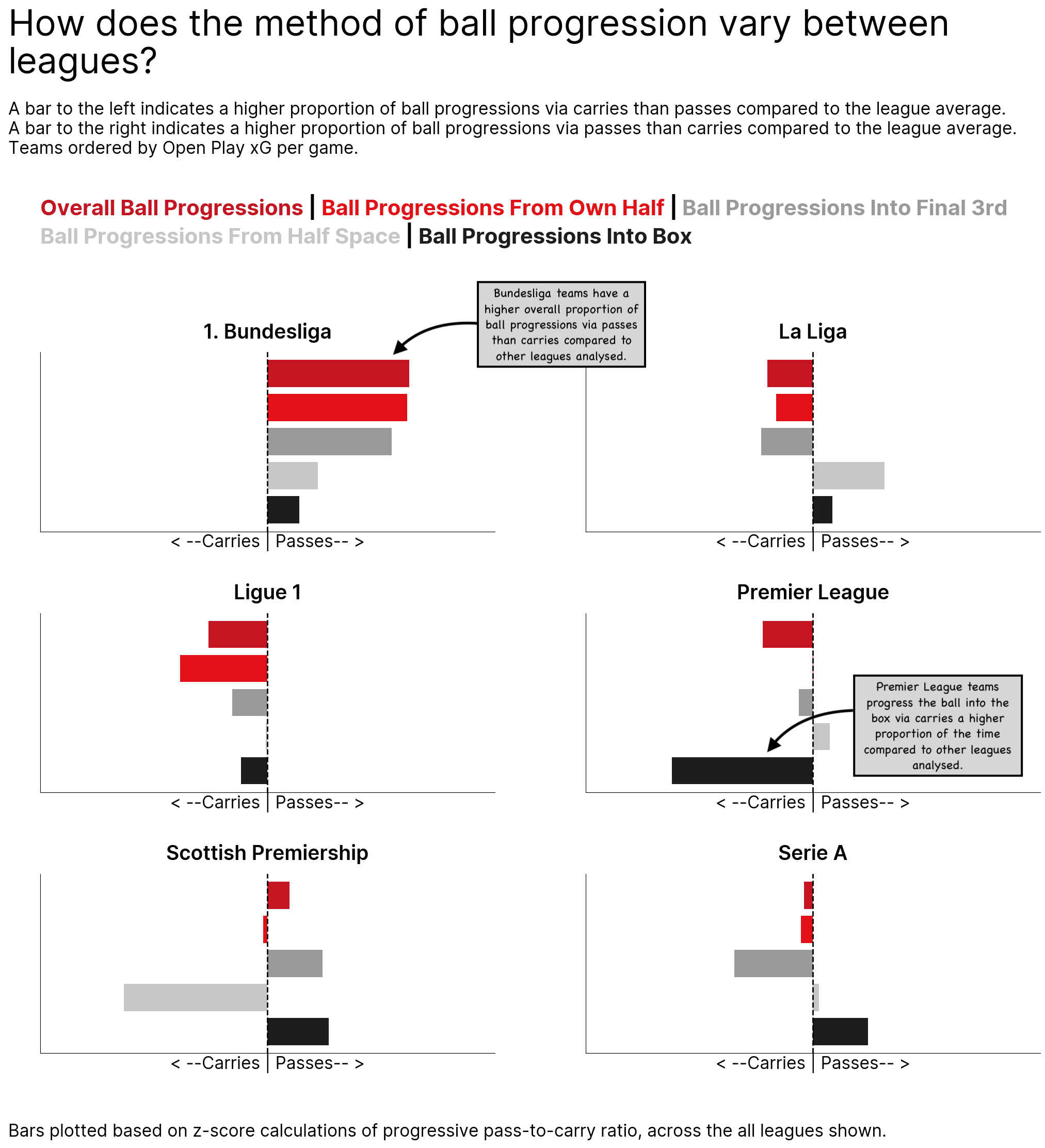
The biggest and most obvious style differentials here are between the German Bundesliga and French Ligue 1. In Germany, teams are much more likely to progress the ball via passes, particularly in the build-up phase, whereas in France you’re more likely to see play move up the pitch with the ball at a player’s feet.
In the Premier League, you’re more likely to see players carry the ball into the penalty box, whilst in La Liga teams will more often use ball carriers to get the ball up the pitch and then use passes for progressions from more advanced areas.
Whilst this admittedly feels a little... *shrugs shoulders and thinks ‘so what?’*... there are the beginnings of some real-world application here, in a recruitment setting. A glance at the preference for carries over passes for progressions from ‘Own Half’ suggests that if you want a ball-carrying Centre Back, then Ligue 1 may be a good starting point. But if your game model requires a CB that can progress the ball via passes from their own territory, then the Bundesliga looks to be a plentiful hunting ground.
StatsBomb now collects data from more than 100 competitions around the world, so by applying these calculations to leagues such as Japan’s J1 League, Brazil’s Serie A, Mexico’s Liga MX or Serbia’s Super Liga, for example, you can start to develop a deeper understanding of differing playing styles across the globe.
Analysing How Teams Progress The Ball
Having established a notion of how ball progression styles vary from league to league, we can now delve into the style differences between teams within each competition.
The first thing that jumps out to me here is that amongst the top attacking teams across Europe (as per xG created), there is a trend towards progressing the ball via carries more often than passing. Compared to peers within their league, Manchester City, Arsenal, Napoli, PSG, Barcelona, Real Madrid, Bayern Munich and Borussia Dortmund all clearly show up on the carry side of the divide, with Liverpool and Inter Milan being the only high-profile teams on the flip side.
Undoubtedly a large part of this is related to the opposition being more likely to sit off when playing against stronger teams, allowing them to carry the ball up the pitch. The real interesting insight comes from comparing teams of a similar standard.
Skimming through the leagues and looking for teams that have strong passing-over-carrying identities shows the likes of Brentford, Bochum, Sampdoria, Strasbourg, Osasuna, Getafe and St Mirren. What insights can we glean by comparing them to teams that we’ve discovered are more prominent ball carriers in their respective leagues?
And once again, we can translate this information to the player recruitment space. Maybe a team like Bochum will find players better suited to their current style of play at Strasbourg and Osasuna, or perhaps teams such as Lorient or Empoli would benefit from widening the net and identifying carry-first teams from South Korea or Argentina.
Specific Team Case Studies
Taking this to a more micro level and looking at individual player actions of two teams with contrasting pass-carry identities and performing to a similar level (in terms of league position this season) reveals some further interesting insights.
By looking at the number of progressive passes and progressive carries per 100 touches, we can see that Brentford are light on ball carriers. In fact, their top progressive ball carrier – Josh da Silva – sits comfortably below 50% of the number of progressive ball carries per touch than that of the top performer in the Premier League for this metric.
Compare and contrast this with Fulham, who have two standout ball carriers. Considering that Willian came into the team as a replacement for the injured Neeskens Kebano, there’s a strong suggestion that this is a key stylistic element of Marco Silva’s team this season.
Similar findings stand true in other leagues analysed. Comparing Lorient with Toulouse shows some clear differences in individual player tendencies, as do Getafe-Valencia and Aberdeen-St Mirren.
Identifying how a team prefers to progress the ball, and which players within that team are prominent in doing so, can be vital information in any next opposition analysis.
Ball Progressing Players
So who are the most prolific ball carriers and progressive passers? And what else can that tell us about a team’s style?
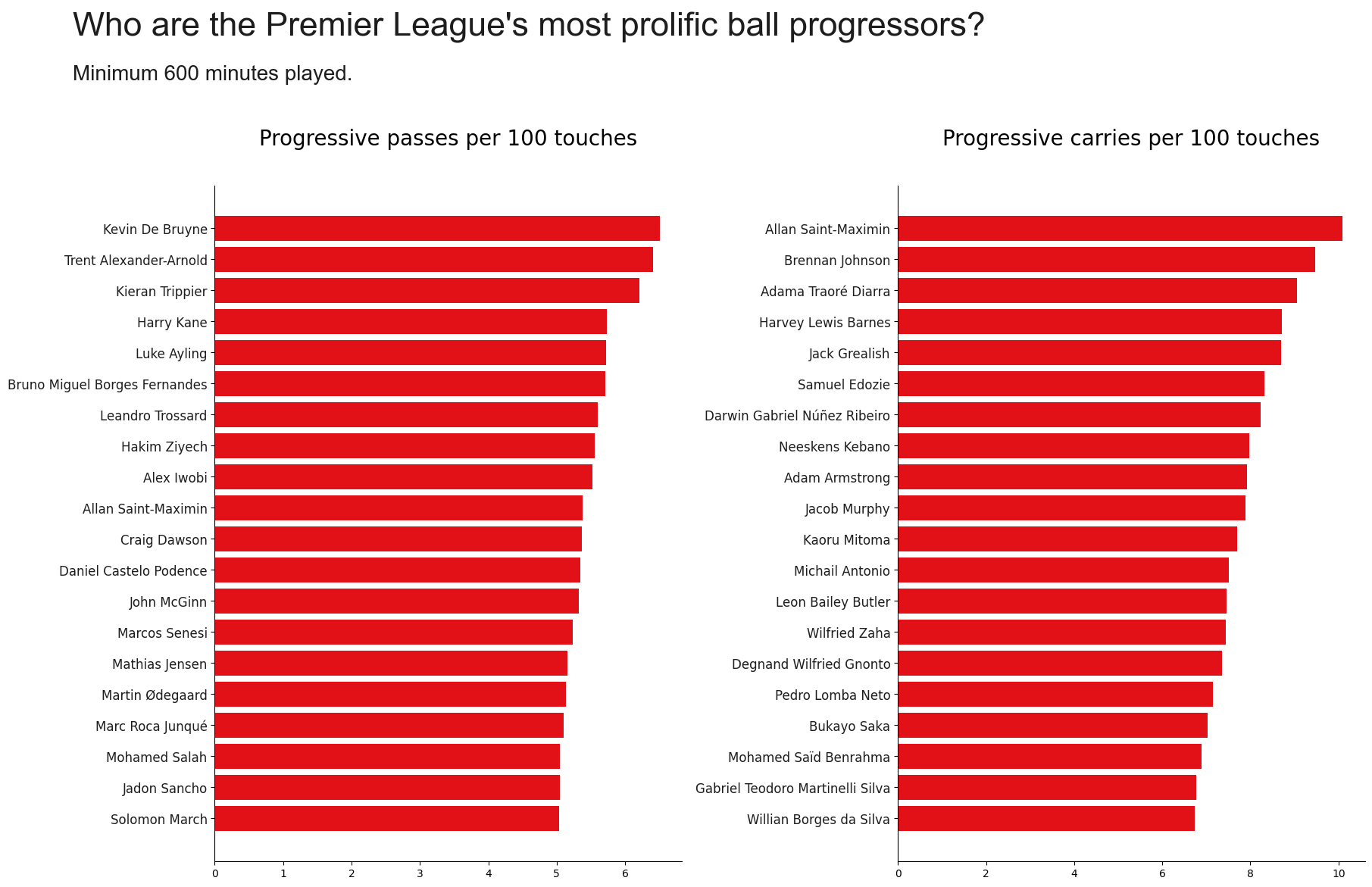
The first thing that jumps out to me here is that Newcastle have a prominent player on both sides of the divide. Allan Saint-Maximin tops the progressive carries chart, and Kieran Trippier ranks 3rd for progressive passes when adjusted for opportunity. That ties in somewhat with the team-level stylistic analysis that shows Newcastle as a team that is almost slap-bang in the middle of the passes-to-carries spectrum in the Premier League.
Also interesting is that the top end of the progressive carriers list has a high proportion of players playing in teams toward the bottom half of the league table – Brennan Johnson, Adama Traoré, Harvey Barnes and Samuel Edozie, to name a few. This is reflective of a combination of these players being amongst the most notorious counter-attacking players in the league and playing in teams that tend to be required to do a lot of defending in their own half.
Furthermore, a cursory glance at some player radars for each of the top performers here clearly shows the stylistic differences between the two and leans further into where this information can be used in the player recruitment space.
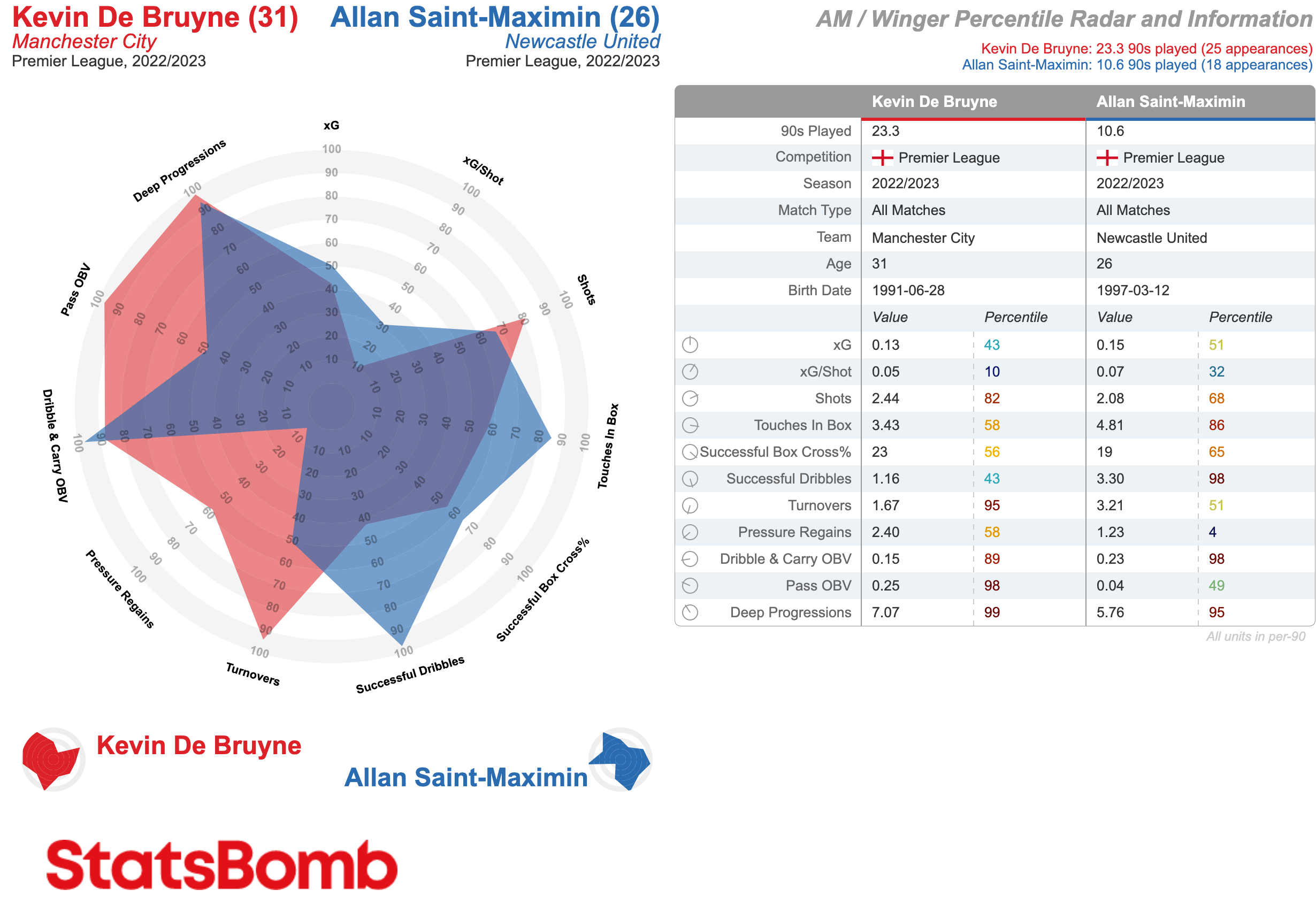
Conclusion
Perhaps the most curious findings are in the differences between league styles and comparing teams within a league outside of the elite performers – i.e. Brentford and Fulham or Getafe and Valencia as above. In these cases, it feels like the differences are more a result of their manager’s teachings than simply having better players at their disposal.
There’s also plenty of signal here that could be used in the player recruitment space if rolled out over a broader range of leagues and across multiple seasons – do some players thrive in a team that progresses the ball via passes rather than carries? Is a particular player’s form suffering because he’s being asked to play in a different way since moving club or a change in manager? Can recruitment analysts identify teams with similar tendencies that will see new signings integrate better into their team’s current set-up?
And to answer the original question posed by our Head of Data Science, Dinesh: the ratio of passes to carries ranges from ~55% to ~75%, amongst the teams analysed. But, the more nuanced response is that really it depends on the league, team, manager and players.

